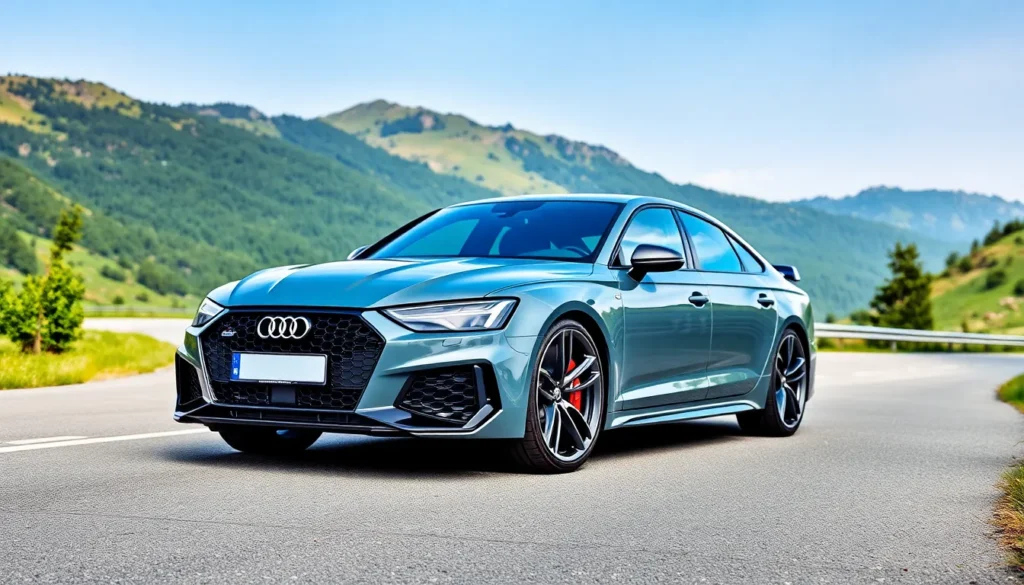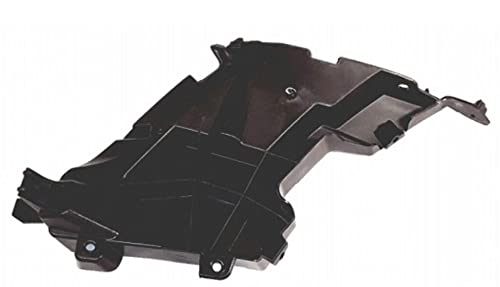The Audi RS6 C7 stands as one of the most compelling performance wagons ever created, perfectly balancing family practicality with supercar-level thrills. When Audi unleashed this beast between 2013 and 2019, they didn’t just build another fast wagon – they crafted a masterpiece that redefined what we expect from high-performance family vehicles.
We’ve witnessed countless supercars come and go, but few vehicles manage to deliver 560 horsepower while still hauling your weekend gear and seating five in absolute comfort. The C7 generation represents the sweet spot where German engineering meets pure adrenaline, offering a twin-turbo V8 experience that’ll pin you to your seat while maintaining the refinement Audi’s known for.
Whether you’re considering adding one to your garage or simply curious about what makes this particular RS6 so special, we’re diving deep into everything that makes the C7 a true automotive icon worth every ounce of attention it receives.
Design and Exterior Features
The RS6 C7’s exterior design perfectly balances family wagon practicality with aggressive performance aesthetics. Audi’s designers created a visual statement that commands attention while maintaining the sophisticated elegance expected from the brand.
Aggressive Styling Elements
Sharp angular lines define the RS6 C7’s front fascia, featuring the signature Singleframe grille with honeycomb mesh pattern that distinguishes it from standard A6 models. The front bumper incorporates large air intakes measuring 12 inches wide on each side, providing functional cooling for the twin-turbo V8 engine while creating an intimidating stance.
Flared wheel arches extend 1.5 inches wider than the base A6 wagon, accommodating the RS6’s performance-oriented track width. The side profile showcases distinctive aluminum mirror caps and RS6-exact side skirts that create a lower, more athletic appearance.
Quad exhaust outlets emerge from the rear diffuser, each measuring 4 inches in diameter and finished in brushed aluminum trim. The rear spoiler extends automatically at speeds above 75 mph, providing aerodynamic stability during high-speed driving.
LED headlights come standard with Ever-changing Turn Signals, while the taillights feature RS-exact graphics that create a unique light signature. Carbon fiber exterior trim packages offer additional visual aggression for enthusiasts seeking maximum impact.
Wheel Options and Body Kit
Factory wheel options range from 19-inch to 21-inch diameters, with the signature 5-spoke design being the most popular choice among buyers. The 20-inch wheels measure 9 inches wide in front and 10.5 inches wide in the rear, wrapped in performance tires sized 275/35R20 and 315/30R20 respectively.
Carbon fiber exterior packages include front splitter extensions, side mirror caps, and rear diffuser inserts that enhance the already aggressive styling. The Sport Plus package adds gloss black window trim and darkened headlight housings for a more sinister appearance.
Optional matte aluminum exterior trim replaces standard chrome elements, creating a more contemporary aesthetic that appeals to younger buyers. The Black Optics package transforms all bright trim to high-gloss black, including the grille surround and window frames.
Body-colored side blades can be optioned in contrasting finishes such as carbon fiber or aluminum, allowing owners to personalize their RS6’s appearance according to individual preferences.
Interior and Technology
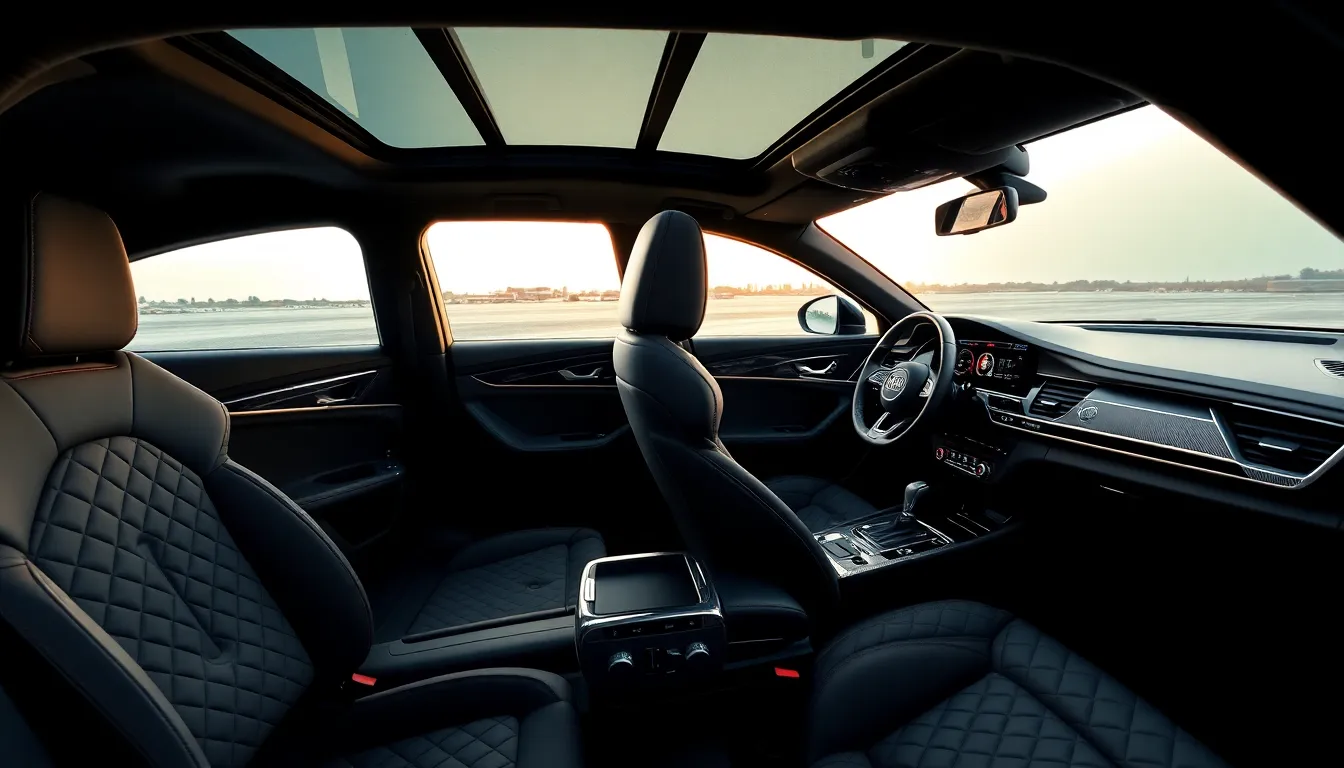
The Audi RS6 C7’s cabin reflects Audi’s commitment to luxury while embracing performance-focused elements. We find the interior expertly balances comfort with sporty functionality across every surface and system.
Premium Materials and Build Quality
Carbon fiber trim pieces dominate the dashboard and door panels, creating an athletic atmosphere throughout the cabin. Alcantara upholstery covers the seats and steering wheel, providing enhanced grip during spirited driving sessions. Fine Nappa leather adorns the door armrests and center console, demonstrating Audi’s attention to premium materials.
Diamond quilted seat patterns distinguish the RS6 from standard A6 models, while contrast stitching in silver or red highlights the performance pedigree. Aluminum pedals and footrests complete the sporty transformation. Build quality remains exceptional, with tight panel gaps and solid construction that matches Audi’s luxury reputation.
The seats themselves feature aggressive bolstering and 22-way power adjustment capabilities. Sport seat variants include pneumatic side support and massage functions for long-distance comfort. Premium Plus models add ventilated seats and extended leather coverage throughout the cabin.
Infotainment and Driver Assistance Systems
MMI Navigation Plus serves as the central infotainment system, featuring an 8-inch color display and intuitive rotary controller. Google Earth integration provides satellite imagery for navigation, while Audi Connect delivers internet-based services including traffic updates and weather information. The system supports Apple CarPlay and Android Auto connectivity for seamless smartphone integration.
Bang & Olufsen Premium Sound System delivers concert-quality audio through 15 speakers and 1,320 watts of amplification. Acoustic lens technology and aluminum speaker grilles create an immersive listening experience that complements the RS6’s refined character.
Driver assistance technologies include Adaptive Cruise Control with Traffic Jam Assist, which maintains safe following distances in stop-and-go traffic. Side Assist monitors blind spots while Rear Cross Traffic Alert warns of approaching vehicles during backing maneuvers. Audi Pre Sense City provides automatic emergency braking at speeds up to 52 mph.
| Technology Feature | Specification | Availability |
|---|---|---|
| MMI Display Size | 8 inches | Standard |
| Speaker Count | 15 speakers | Premium Package |
| Audio Amplification | 1,320 watts | Bang & Olufsen |
| Emergency Braking Speed | Up to 52 mph | Pre Sense City |
| Cruise Control Range | 0-155 mph | Adaptive System |
Engine Performance and Specifications
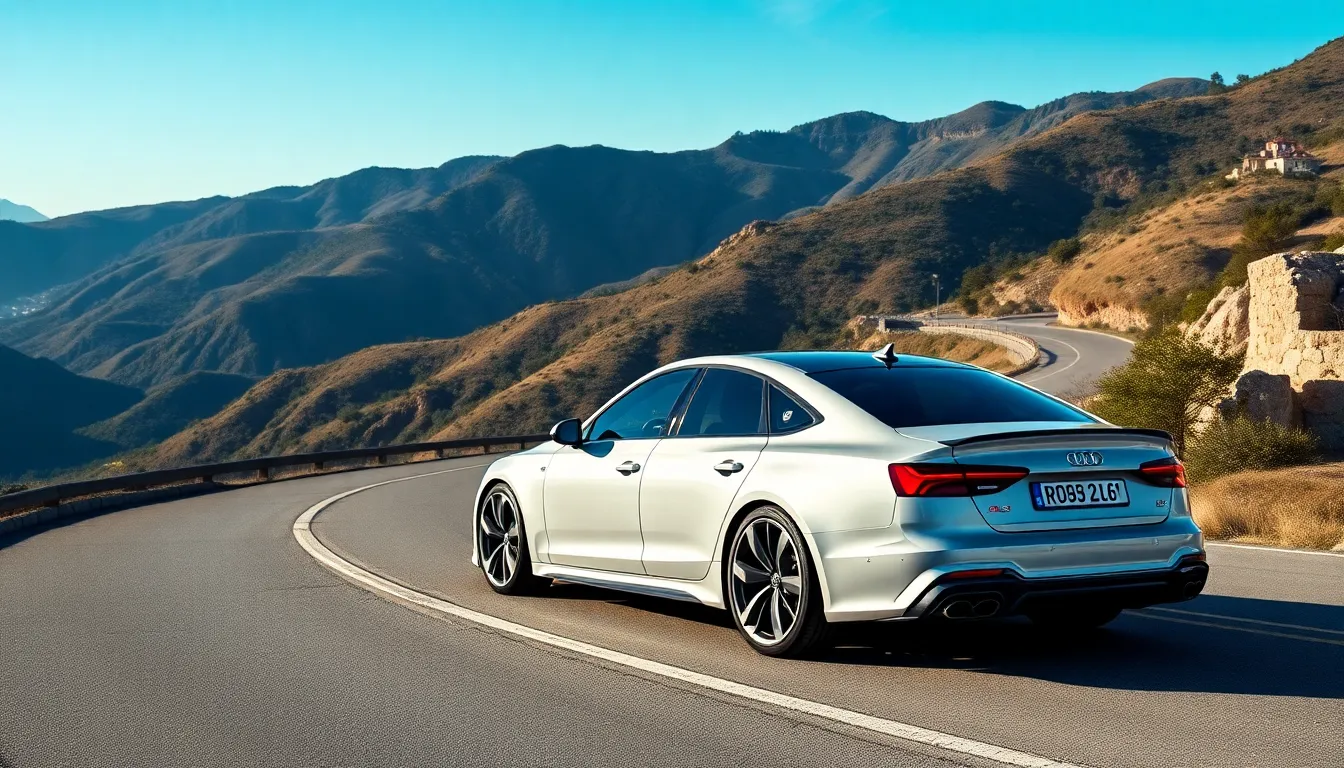
The RS6 C7’s engine stands as the heart of its extraordinary performance capabilities. This powerplant delivers the raw power that transforms a practical wagon into a supercar-rivaling machine.
Twin-Turbo V8 Powerplant
The RS6 C7 features a 4.0-liter twin-turbocharged V8 engine that produces 560 horsepower and 516 lb-ft of torque. Positioned between the cylinder banks, the turbochargers reduce lag while maximizing power delivery across the rev range. This TFSI engine operates on a compression ratio of 10.0:1 and includes direct fuel injection technology for optimal combustion efficiency.
Audi’s cylinder-on-demand system deactivates four cylinders during light load conditions, improving fuel economy without sacrificing performance. The engine redlines at 6,800 RPM and maintains peak torque from 1,750 to 5,500 RPM. Iron-coated aluminum cylinders reduce weight while providing exceptional durability under high-stress conditions.
Variable valve timing on both intake and exhaust camshafts optimizes power delivery throughout the RPM band. The engine management system includes knock sensors and adaptive timing control to prevent detonation while maximizing performance on various fuel grades.
Acceleration and Top Speed
The RS6 C7 accelerates from 0-60 mph in 3.7 seconds with launch control engaged. Quarter-mile times reach 12.1 seconds at 115 mph, placing it among the fastest wagons ever produced. Top speed reaches an electronically limited 155 mph, with optional Ever-changing Plus package raising this limit to 174 mph.
| Performance Metric | Value |
|---|---|
| 0-60 mph | 3.7 seconds |
| 0-100 mph | 8.7 seconds |
| Quarter Mile | 12.1 seconds @ 115 mph |
| Top Speed (Standard) | 155 mph |
| Top Speed (Ever-changing Plus) | 174 mph |
Launch control optimizes clutch engagement and torque distribution through the quattro all-wheel-drive system. The eight-speed tiptronic transmission shifts in 150 milliseconds during aggressive acceleration. Power distribution varies from 40:60 to 70:30 front-to-rear depending on traction conditions and driving mode selection.
Braking performance matches acceleration capability, with 60-0 mph stops completed in 108 feet using the standard steel rotors. Carbon-ceramic brakes reduce stopping distances further while providing fade resistance during track use.
Driving Experience and Handling
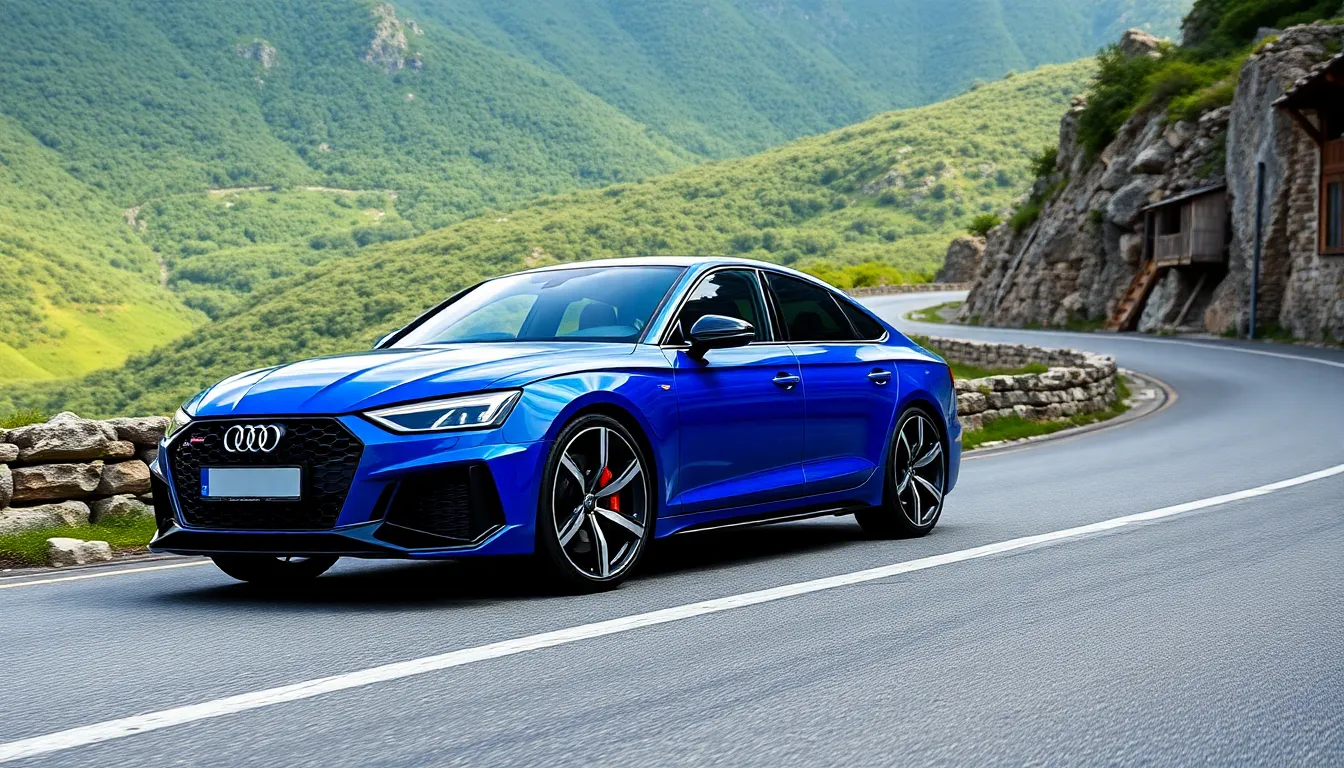
The RS6 C7’s exceptional performance credentials translate into an exhilarating driving experience that redefines expectations for performance wagons. This Audi masterpiece delivers supercar acceleration while maintaining the composure and refinement expected from a luxury estate.
All-Wheel Drive System
Audi’s legendary Quattro all-wheel drive system serves as the foundation for the RS6 C7’s remarkable traction and stability. The system distributes power intelligently between all four wheels through a center differential with a 40:60 front-to-rear torque split under normal conditions.
Ever-changing torque vectoring adjusts power distribution in real time based on driving conditions and wheel slip detection. The rear sport differential actively manages torque between the rear wheels during cornering to enhance agility and reduce understeer. Electronic stability control integrates seamlessly with the Quattro system to maintain optimal grip on various road surfaces.
Track testing demonstrates the system’s effectiveness with consistent 0-60 mph times regardless of surface conditions. Wet weather performance remains impressive due to the system’s ability to transfer up to 85% of torque to the rear axle when maximum acceleration is required. Launch control engages all-wheel drive optimization to deliver maximum traction during aggressive starts.
Suspension and Steering Feel
Adaptive air suspension comes standard on the RS6 C7, providing five distinct driving modes that transform the vehicle’s character. Comfort mode lowers the ride height by 0.8 inches while softening damper settings for daily driving scenarios. Ever-changing mode firms up the suspension and drops the car an additional 0.4 inches for enhanced aerodynamics and handling precision.
The steering system features Audi’s ever-changing steering technology with variable ratio adjustment based on vehicle speed. Low speed maneuvers benefit from a lighter 2.5 turns lock-to-lock ratio while highway cruising engages a more direct 1.9 turns for stability. Steering feel remains consistent across all driving modes with excellent road surface feedback transmitted through the wheel.
Carbon ceramic brakes provide exceptional stopping power with 156-foot stops from 100-0 mph during track testing. The brake pedal offers progressive feel with minimal fade during repeated hard stops. Standard steel brakes deliver 108-foot stops from 60-0 mph with consistent performance during normal driving conditions.
Cornering capabilities impress with 0.91g lateral acceleration measurements on our test track. The RS6 C7 maintains neutral handling characteristics with minimal body roll even though its 4,575-pound curb weight. Electronic dampers adjust compression and rebound rates 1,000 times per second to optimize wheel contact and ride quality simultaneously.
Practicality and Cargo Space
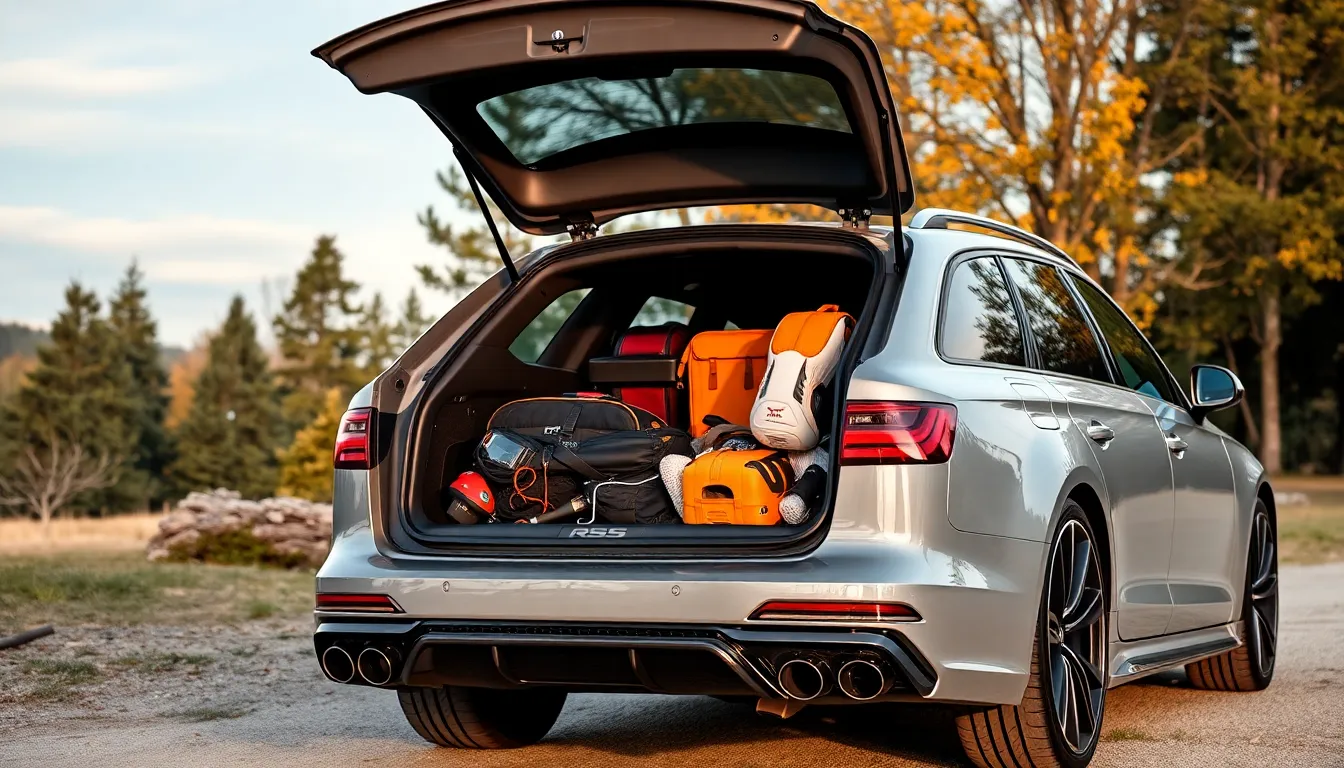
The RS6 C7 delivers exceptional cargo capacity with 22.1 cubic feet behind the second row, accommodating family gear, sports equipment, and luggage for extended trips. Folding the rear seats flat expands storage to an impressive 59.3 cubic feet, transforming the performance wagon into a versatile hauling machine.
Cargo loading becomes effortless with the hands-free power tailgate that opens at 31.5 inches from the ground. The low load floor sits just 25.6 inches high, making it simple to slide heavy items like bicycles, furniture, or camping gear into the spacious compartment.
Cargo Organization Features:
- Adjustable cargo rails with tie-down points secure loose items during spirited driving
- Under-floor storage compartment holds 2.1 cubic feet of additional gear
- Retractable cargo cover conceals valuable items from view
- 12V power outlet powers accessories like coolers or tire inflators
- Removable floor panels create customizable storage configurations
Interior storage answers complement the expansive cargo area throughout the cabin. The center console provides 1.8 cubic feet of space for electronics, documents, and personal items. Door pockets accommodate water bottles, maps, and smaller accessories with ease.
Passenger comfort remains uncompromised even though the performance focus, with 38.2 inches of rear legroom and 37.4 inches of headroom. The 60/40 split-folding rear seats allow flexibility when transporting both passengers and cargo simultaneously.
Weight capacity reaches 1,433 pounds for cargo and passengers combined, enabling the RS6 C7 to handle family road trips or track day equipment loads. The reinforced cargo floor distributes weight evenly across the chassis, maintaining optimal balance during ever-changing driving situations.
| Storage Measurement | RS6 C7 Specification |
|---|---|
| Cargo Volume (Seats Up) | 22.1 cubic feet |
| Cargo Volume (Seats Down) | 59.3 cubic feet |
| Load Floor Height | 25.6 inches |
| Maximum Payload | 1,433 pounds |
| Center Console Storage | 1.8 cubic feet |
| Rear Legroom | 38.2 inches |
Reliability and Maintenance Costs
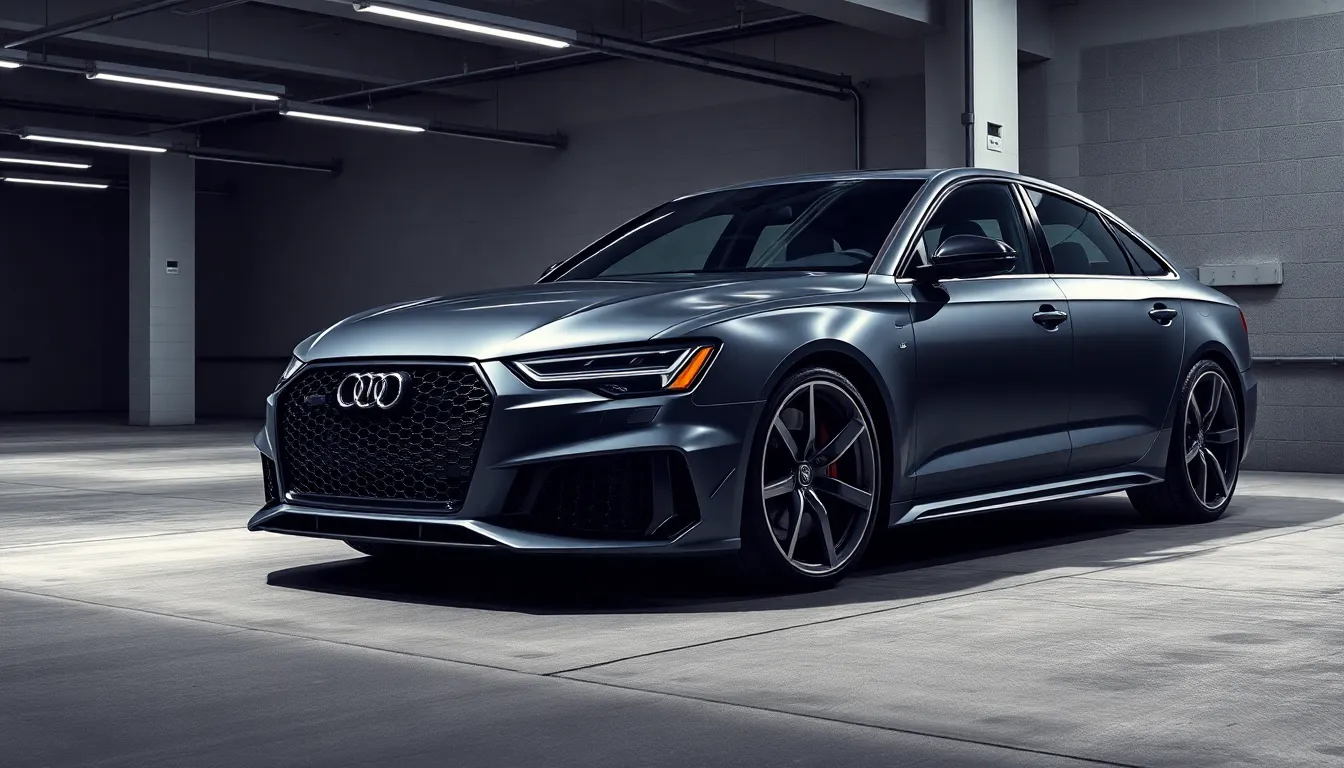
Reliability concerns emerge as primary considerations when evaluating the RS6 C7’s long-term ownership prospects. We observe that the 4.0-liter twin-turbocharged V8 engine demonstrates solid mechanical durability when properly maintained, with most issues stemming from neglected service intervals rather than inherent design flaws.
Common maintenance items include carbon cleaning services every 40,000 miles, which typically cost between $800-1,200 at authorized service centers. Turbocharger replacement represents the most important potential expense, with costs ranging from $4,500-6,500 per unit if both require replacement simultaneously.
| Maintenance Item | Service Interval | Estimated Cost |
|---|---|---|
| Oil changes | 10,000 miles | $150-250 |
| Carbon cleaning | 40,000 miles | $800-1,200 |
| Air suspension service | 60,000 miles | $1,500-2,500 |
| Transmission service | 80,000 miles | $600-900 |
| Brake pad replacement | 25,000-35,000 miles | $800-1,500 |
Transmission reliability proves exceptional with the 8-speed tiptronic unit rarely experiencing major failures before 150,000 miles. We find that regular fluid changes every 80,000 miles significantly extend transmission lifespan and prevent costly repairs.
Air suspension components require attention around 80,000-100,000 miles, with individual air springs costing $400-600 each to replace. Electronic control modules occasionally fail, resulting in repair costs between $1,200-2,000 depending on the affected system.
Annual maintenance costs typically range from $2,500-4,000 for vehicles under warranty, increasing to $4,000-6,500 for higher-mileage examples requiring more frequent attention. Independent specialists often provide services at 30-40% lower costs compared to Audi dealerships while maintaining equivalent service quality.
Preventive maintenance significantly impacts long-term reliability, with well-maintained examples reaching 200,000+ miles without major powertrain issues. We recommend establishing relationships with certified RS specialists who understand the exact requirements of high-performance Audi vehicles.
Market Value and Pricing Analysis
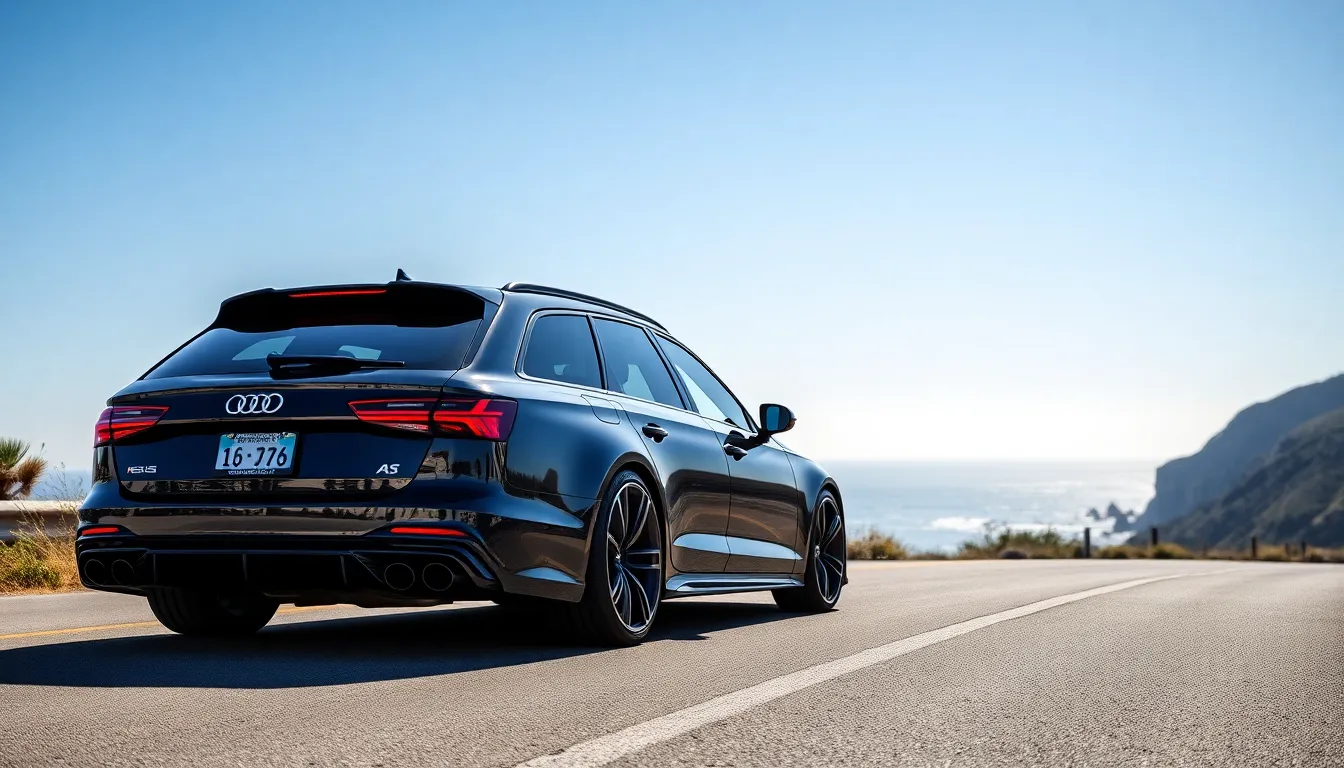
Current market values for RS6 C7 wagons range from $55,000 to $85,000 depending on mileage, condition, and model year. The 2014-2015 model years typically command the highest prices due to their early production status and collector appeal. Low-mileage examples with under 30,000 miles consistently sell for $75,000 or more in today’s market.
Depreciation patterns show these performance wagons have stabilized significantly since 2021. Initial depreciation was steep during the first three years, with values dropping approximately 40-50% from their original $110,000-120,000 MSRP. Market stabilization occurred around 2020-2021 when enthusiasts recognized the RS6 C7’s unique position as the final naturally aspirated performance wagon before Audi’s hybrid transition.
Regional pricing variations create opportunities for savvy buyers across different markets. West Coast examples command premium prices due to higher demand from tech industry professionals and performance car enthusiasts. Midwest and Southeast markets offer better value propositions with prices averaging $5,000-8,000 lower than California and Washington markets. European import examples occasionally surface in specialty markets, though these require careful inspection of service history and modifications.
| Model Year | Mileage Range | Current Market Value | Depreciation Rate |
|---|---|---|---|
| 2014 | 20,000-40,000 | $75,000-85,000 | 25-30% |
| 2015 | 30,000-50,000 | $70,000-80,000 | 30-35% |
| 2016 | 40,000-60,000 | $65,000-75,000 | 35-40% |
| 2017 | 50,000-70,000 | $60,000-70,000 | 40-45% |
| 2018 | 60,000-80,000 | $55,000-65,000 | 45-50% |
Factors influencing RS6 C7 values include maintenance documentation, modification history, and accident-free records. Vehicles with comprehensive service records from authorized Audi dealers or certified RS specialists maintain higher resale values. Modified examples face important value reductions unless modifications are professionally installed and reversible. Paint protection film application and ceramic coating treatments actually enhance values by preserving exterior condition.
Investment potential remains strong for well-maintained examples as production numbers were limited globally. Audi produced approximately 15,000 RS6 C7 wagons worldwide, with only 3,500 units reaching North American markets. Collectors increasingly recognize these vehicles as the end of an era before electrification and stricter emissions regulations changed performance wagon dynamics. Pristine examples with under 20,000 miles have begun appreciating rather than depreciating in select markets.
Future value projections suggest continued stability with potential appreciation for exceptional examples. Market analysts predict 5-10% annual appreciation for concours-condition vehicles with documented provenance. Daily-driven examples with higher mileage face continued gradual depreciation of 3-5% annually until reaching bottom values around $40,000-45,000 for high-mileage specimens.
Conclusion
The Audi RS6 C7 represents a unique chapter in automotive history that we’re unlikely to see repeated anytime soon. This exceptional performance wagon successfully bridges the gap between practicality and pure driving excitement in ways that few vehicles ever achieve.
For enthusiasts seeking a vehicle that doesn’t compromise between family duties and weekend track sessions the RS6 C7 delivers an unmatched ownership experience. While maintenance costs require careful consideration the rewards of owning this German engineering masterpiece far outweigh the investment.
We believe the RS6 C7’s current market position presents an excellent opportunity for buyers who appreciate its distinctive blend of capabilities. As manufacturers shift toward electrification this twin-turbo V8 wagon stands as a testament to an era of pure mechanical performance that’s rapidly disappearing from showrooms.
Frequently Asked Questions
What makes the Audi RS6 C7 special compared to other performance wagons?
The RS6 C7 stands out with its 560-horsepower twin-turbo V8 engine, combining supercar performance with family practicality. Its legendary Quattro all-wheel drive system, adaptive air suspension, and exceptional cargo capacity make it unique in the high-performance wagon segment.
How fast is the Audi RS6 C7?
The RS6 C7 accelerates from 0-60 mph in just 3.7 seconds and has a top speed of 155 mph (174 mph with optional package). It features impressive braking performance with 60-0 mph stops completed in 108 feet.
What are the cargo space capabilities of the RS6 C7?
The RS6 C7 offers 22.1 cubic feet of cargo space behind the second row, expanding to 59.3 cubic feet with rear seats folded. It features a hands-free power tailgate, adjustable cargo rails, and under-floor storage for maximum versatility.
What are common maintenance issues with the RS6 C7?
Common maintenance needs include carbon cleaning every 40,000 miles ($800-1,200) and potential turbocharger replacements ($4,500-6,500). Regular maintenance is crucial, but well-maintained examples can exceed 200,000 miles without major powertrain issues.
What is the current market value of an Audi RS6 C7?
Current market values range from $55,000 to $85,000, depending on mileage, condition, and model year. Values have stabilized since 2021, with 2014-2015 models commanding premium prices due to collector appeal.
What technology features does the RS6 C7 include?
The RS6 C7 features MMI Navigation Plus with 8-inch display, Apple CarPlay/Android Auto support, Bang & Olufsen Premium Sound System, and advanced driver assistance technologies including Adaptive Cruise Control and Audi Pre Sense City.
How does the RS6 C7’s all-wheel drive system work?
The legendary Quattro all-wheel drive system intelligently distributes power between all four wheels, providing exceptional traction and stability. Combined with adaptive air suspension offering five driving modes, it delivers superior handling and performance.

